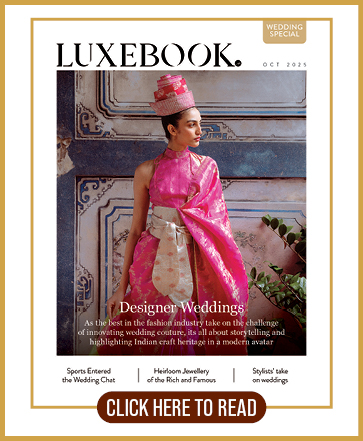How Vintage Cars Are Turning Modern Weddings Into High-End Arrival Spectacles
In the glittering chaos of India’s wedding season, luxury has found a new lane (quite literally). From the narrow bypaths of Prayagraj to the manicured (with extensions) driveways of Delhi’s farmhouses, vintage motors, baggis, and Bentleys are becoming the latest ‘must-have’ accessories for the modern baraat.

Grooms are arriving in cars that once belonged to princely families, while brides opt for pastel-hued convertibles adorned with orchids and chiffon drapes.

The demand for vintage luxury cars and traditional horse-drawn carriages has undeniably surged sharply this season; rental agencies are booked out weeks in advance (with everything from a 1960s Impala to a silver Rolls-Royce Phantom being polished to perfection) for grand wedding entries and wedding planners have included options in their roster. The cost? Upto and over ₹1 lakh per event, depending on the model, distance, and exclusivity (of your choice, and the crowd).
But these aren’t just cars—they’re character studies. Each polished bonnet and leather-stitched seat carries a lineage of craftsmanship that today’s luxury market often strives to recreate.In Rajasthan, where heritage reigns supreme, curated collections from royal garages are even being offered for rent. At Udaipur’s Lake Palace weddings, Rolls-Royces once used by maharajas are making encore appearances—restored, detailed, and reborn as icons of timeless luxury.

The Maharaja Who Humiliated Rolls-Royce
For example, the infamous story of Jai Singh Prabhakar, the Maharaja of Alwar: after being snubbed by Rolls-Royce salesmen in London in 1920, who mistook him for a man of modest means, the Maharaja returned to the showroom in full royal splendour, purchased all six cars on display (paid for them on the spot), and shipped them to India.

Once home, he ordered that the gleaming Rolls-Royces be used to collect garbage on the streets of New Delhi. The public humiliation forced the British automaker to issue an apology and offer him additional cars as an act of goodwill.

Initially dismissed for appearing ‘too poor” to afford the cars, he later returned in royal regalia, bought the entire showroom fleet; and it is stories like this that foster communal heritage, and fuels India’s fascination with vintage automobiles, where every gleaming bonnet carries not just prestige, but a touch of poetic rebellion.

A 1962 Cadillac Fleetwood, a mint-condition Morris Oxford, a navy-blue Rolls-Royce Silver Shadow—these vehicles aren’t hired merely for transport, but for storytelling (colonial arrogance staging a ‘moment’). The aesthetic appeal, however, is only half the allure.

In an age where supercars and SUVs dominate urban driveways, vintage vehicles offer a counterpoint—a slow luxury, steeped in emotion and elegance. Their imperfections—the soft hum of an engine, the gleam of age-worn metal—are what make them desirable.
Luxury planners suggest that the trend speaks to a wider cultural movement: a yearning for authenticity and history in an increasingly hyper-modern wedding landscape. The vintage car, with its regal proportions and tactile charm, has become the modern-day chariot—bridging nostalgia and spectacle.

A vintage Rolls isn’t just a car—it’s a moving prop in a love story. The moment the couple steps out, it’s like a scene from an old film, complete with brass trumpets and flashbulbs.

The evolution of the Indian wedding continues to mirror its times: rooted in heritage, yet endlessly reinvented (unlike the engines for these vintage Cadillacs need constant maintenance- even more than the bride’s pre-wedding upkeep).In Prayagraj, couples are requesting cars once owned by royal families or former politicians, seeking not just beauty but stories embedded in history.

Perhaps no gesture captures that balance better than arriving in something that has already lived a hundred stories?and still gleams under the spotlight (and you hope doesn’t stop midway and outperform the dhols in the distance). Parades like these aren’t merely about transport to flaunt—it’s about theatre.
The arrival has become an extension of the couple’s aesthetic and narrative. Whether it’s a groom rolling in on a vintage convertible draped in marigolds, or a bride making her debut in a baggi illuminated with fairy lights and live folk music, the “entry” is now treated as a cinematic moment—complete with drone footage, custom playlists, and designer florals.

The trend also aligns with India’s larger luxury evolution—where personalisation and experience often trump ownership. While destination weddings corner the glamour narrative, city weddings are now leaning into nostalgia, invoking heritage through design and decor. The return of horse-drawn carriages—especially those decked with Swarovski-encrusted harnesses or antique brass fittings—adds a fairy-tale charm that blends old-world romance with new-age opulence.

Industry experts suggest this boom isn’t just limited to north India. In cities like Jaipur and Udaipur, the market for wedding transport experiences is expanding beyond cars—from hot-air balloon entries, boat baraats across Lake Pichola, or drone-led processions that mimic royal coronations. Clearly, he wedding season of 2026 stands polished, ready to enthral its it’s loyal onlookers!
You may also read: A Look At October’s Biggest Luxury Moments



